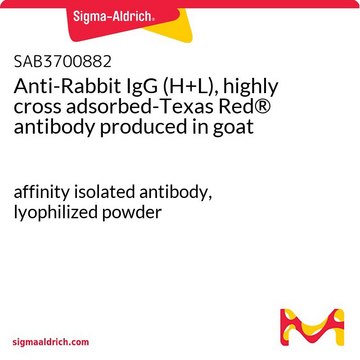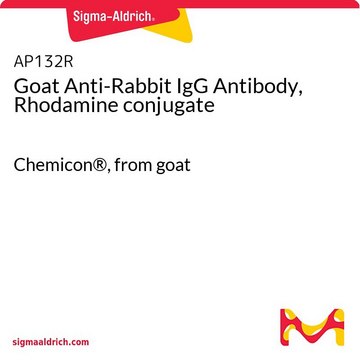AP187F
Goat Anti-Rabbit IgG Antibody, FITC conjugate, Species Adsorbed
Chemicon®, from goat
Sign Into View Organizational & Contract Pricing
All Photos(1)
About This Item
UNSPSC Code:
12352203
eCl@ss:
32160702
NACRES:
NA.46
Recommended Products
biological source
goat
Quality Level
conjugate
FITC conjugate
antibody form
affinity purified immunoglobulin
antibody product type
secondary antibodies
clone
polyclonal
species reactivity
rabbit
manufacturer/tradename
Chemicon®
technique(s)
ELISA: suitable
immunofluorescence: suitable
isotype
IgG
shipped in
wet ice
target post-translational modification
unmodified
General description
IgG is one of the most abundant protein in human serum. IgG is important for our defence against microorganisms and the molecules are produced by B-lymphocytes as a part of our adaptive immune response. The IgG molecule has two separate functions; to bind to the pathogen that elicited the response and to recruit other cells and molecules to destroy the antigen.
Specificity
The antibody reacts with whole molecule rabbit IgG. It also reacts with the llight chains of other rabbit immunoglobulins. The antibody has been tested by ELISA and adsorbed to ensure minimal cross-reaction with human, mouse and rat immunoglobulins.
Application
Goat anti-Rabbit IgG Antibody, FITC conjugate, Species Adsorbed detects level of Rabbit IgG & has been published & validated for use in ELISA & IF.
Research Category
Secondary & Control Antibodies
Secondary & Control Antibodies
Research Sub Category
Secondary Antibodies Adsorbed for Dual Labeling
Secondary Antibodies Adsorbed for Dual Labeling
Physical form
Immunoaffinity Chromatography
Purified from immunoaffinity chromatography. Lyophilized from 0.01 M Sodium Phosphate, 0.25 M NaCl, pH 7.6, 15 mg/ml Bovine Serum Albumin (Protease-Free, IgG-Free) and 0.05 Sodium Azide.
Storage and Stability
Maintain lyophilized product at 2°-8°C for up to 12 months. After reconstitution the product is stable for six weeks at 2°-8°C in the dark as an undiluted liquid. Reconstitute vial with of distilled water (addition of 1 ml water will yield a final concentration of 1.5 mg/mL). For extended storage after reconstitution, add an equal volume of glycerol to make a final concentration of 50% glycerol followed by storage at -20°C in undiluted aliquots for up to 12 months. Please note the concentration of protein (and buffer salts) will decrease to one-half of the original after the addition of glycerol. Avoid repeated freeze thaw cycles. Keep away from light.
Legal Information
CHEMICON is a registered trademark of Merck KGaA, Darmstadt, Germany
Disclaimer
Unless otherwise stated in our catalog or other company documentation accompanying the product(s), our products are intended for research use only and are not to be used for any other purpose, which includes but is not limited to, unauthorized commercial uses, in vitro diagnostic uses, ex vivo or in vivo therapeutic uses or any type of consumption or application to humans or animals.
Not finding the right product?
Try our Product Selector Tool.
Hazard Statements
Precautionary Statements
Hazard Classifications
Aquatic Chronic 3
Storage Class Code
11 - Combustible Solids
WGK
WGK 3
Certificates of Analysis (COA)
Search for Certificates of Analysis (COA) by entering the products Lot/Batch Number. Lot and Batch Numbers can be found on a product’s label following the words ‘Lot’ or ‘Batch’.
Already Own This Product?
Find documentation for the products that you have recently purchased in the Document Library.
Endocrine and exocrine secretion of leptin by the gastric mucosa.
Cammisotto, PG; Renaud, C; Gingras, D; Delvin, E; Levy, E; Bendayan, M
The journal of histochemistry and cytochemistry : official journal of the Histochemistry Society null
Secretion of soluble leptin receptors by exocrine and endocrine cells of the gastric mucosa.
Cammisotto, PG; Gingras, D; Renaud, C; Levy, E; Bendayan, M
American Journal of Physiology: Gastrointestinal and Liver Physiology null
Nien-Che Liu et al.
Pharmaceutics, 14(5) (2022-05-29)
Stem cell-based in vitro models may provide potential therapeutic strategies and allow drug screening for neurodegenerative diseases, including Alzheimer's disease (AD). Herein, we develop a neural stem cell (NSC) spheroid-based biochip that is characterized by a brain-like structure, well-defined neural
Sneham Tiwari et al.
Frontiers in aging neuroscience, 10, 291-291 (2018-10-26)
Neurological disorders are the biggest concern globally. Out of ~36 million human immunodeficiency virus (HIV) positive people, about 30%-60% exhibit neurological disorders, including dementia and Alzheimer's disease (AD) like pathology. In AD or AD like neurological disorders, the pathogenesis is
Daniel Sousa-Rocha et al.
PloS one, 10(10), e0139569-e0139569 (2015-10-03)
Neutrophils release fibrous traps of DNA, histones, and granule proteins known as neutrophil extracellular traps (NETs), which contribute to microbicidal killing and have been implicated in autoimmunity. The role of NET formation in the host response to nonbacterial pathogens is
Our team of scientists has experience in all areas of research including Life Science, Material Science, Chemical Synthesis, Chromatography, Analytical and many others.
Contact Technical Service







